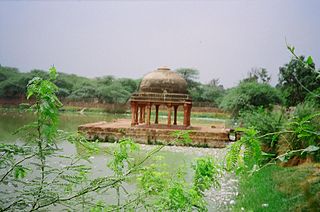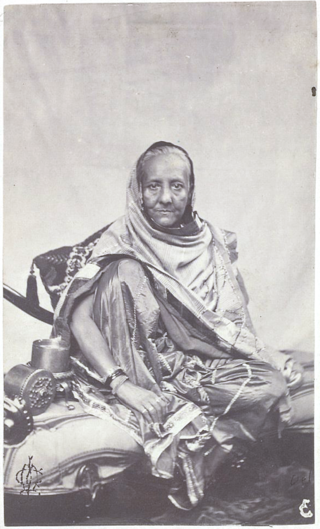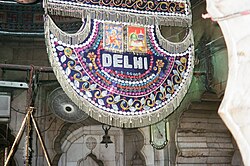
Bahadur Shah II, usually referred to by his poetic title Bahadur Shah Zafar, was the twentieth and last Mughal emperor, as well as an Urdu poet. He was the second son and the successor to his father, Akbar II, who died in 1837. He was a titular Emperor, as the Mughal Empire existed in name only and his authority was limited only to the walled city of Old Delhi (Shahjahanbad). Following his involvement in the Indian Rebellion of 1857, the British deposed him and exiled him to Rangoon in the British-controlled Burma in 1858, after convicting him on several charges. The title of Empress of India was subsequently transferred to Queen Victoria.

Akbar II, also known as Akbar Shah II, was the nineteenth Mughal emperor from 1806 to 1837. He was the second son of Shah Alam II and the father of Bahadur Shah II, who would eventually succeed him and become the last Mughal emperor.

Mehrauli is a neighbourhood in South Delhi, Delhi, India. It represents a constituency in the legislative assembly of Delhi. The area is close to Gurugram and next to Vasant Kunj.
Sarai Kale Khan is a village in South East Delhi district in Delhi. This is a Gurjar village of clan Basista/Bosatta. This place is remotely connected to other parts of Delhi through the means of Delhi Metro Pink Line. It also has Inter-State Bus Terminus. It is adjacent to the Hazrat Nizamuddin Railway Station. It is one of the five main stations in Delhi and is the originating and terminal station for 60 trains. Sarai Kale Khan is the terminus for most buses heading for towns south of Delhi. It is also a DTC bus depot for the Mudrika Seva and many other bus routes.

The Moti Masjid is a white marble mosque inside the Red Fort complex in Delhi, India. Located to the west of the Hammam and close to the Diwan-i-Khas, it was built by the Mughal emperor Aurangzeb from 1659 to 1660.

Quṭb al-Aqṭāb Khwāja Sayyid Muḥammad Bakhtiyār al-Ḥusaynī, Quṭb al-Dīn Bakhtiyār Kākī was a Sunni Muslim Sufi mystic, saint and scholar of the Chishti Order from Delhi, India. He was the disciple and the spiritual successor of Mu'in al-Din Chishti as head of the Chishti order, and the person to whom the Qutb Minar, Delhi is dedicated. Before him the Chishti order in India was confined to Ajmer and Nagaur. He played a major role in establishing the order securely in Delhi. His dargah located adjacent to Zafar Mahal in Mehrauli, and the oldest dargah in Delhi, is also the venue of his annual Urs festivities. The Urs was held in high regard by many rulers of Delhi like Qutb ud-Din Aibak, Iltutmish who built a nearby stepwell, Gandhak ki Baoli for him, Sher Shah Suri who built a grand gateway, Bahadur Shah I who built the Moti Masjid mosque nearby and Farrukhsiyar who added a marble screen and a mosque.

Yogmaya Temple, also Jogmaya temple, is a Hindu temple dedicated to the goddess Yogmaya, also considered to be a sister of Krishna as she took avatar as Vindhyavasini, and situated in Mehrauli, New Delhi, India, close to the Qutb complex. According to local priests and native records, this is one of those 27 temples destroyed by Mamluks and it is the only surviving temple belonging to pre-sultanate period which is still in use. Hindu king Samrat Vikramaditya Hemu reconstructed the temple and brought back the temple from ruins. During Aurangzeb's reign a rectangular Islamic Style hall was added to the temple. Though its original architecture could never be restored after its destruction by Islamic rulers, but its reconstruction had been carried out repetitively by the locals.

Hauz-i-Shamsi, also called Shamshi Talab, is a water storage reservoir or tank built by Iltutmish of the Slave Dynasty in 1230 CE, at a location revealed to him in a dream by the Islamic prophet Muhammad. A palace called the Jahaz Mahal was built on the eastern edge of the same reservoir during the Lodi dynasty period in the 16th century as a retreat or Inn for use by pilgrims. Also at the edge of Hauz is the tomb of 17th-century Persian writer in the Mughal court, Abdul-Haqq Dehlavi. The monuments are situated in Mehrauli, Delhi.

Jahaz Mahal, is located next to Hauz-i-Shamsi in Mehrauli, Delhi on its northeastern corner. It was so named, since its reflection (illusion) in the surrounding reservoir looked like a ship floating on a lake. It is inferred to have been built during the Lodi dynasty period (1452–1526) as a pleasure resort, Sarai or an inn.

Zafar Mahal, in Mehrauli village, in South Delhi, India, is considered as the last monumental structure built as a summer palace during the fading years of the Mughal era. The building has two components namely, the Mahal or the palace, which was built first by Akbar Shah II in the 18th century, and the entrance gate that was reconstructed in the 19th century by Bahadur Shah Zafar II, popularly known as "Zafar" meaning ‘Victory’. It has a forlorn history because Bahadur Shah Zafar, who wished to be buried in the precincts of the Zafar Mahal (palace) and the famous Dargah of Khwaja Qutubuddin Bakhtiar Kaki in Mehrauli, Delhi, was deported by the British to Rangoon, after the First War of Indian Independence in 1857, where he died of old age. The monument today is in a neglected and ruined state, locals play cricket and gamble freely inside the protected monument. The 18th-century palace has been all but subsumed by unauthorised constructions.
The town of Sautbad, known as Sheikhupur, is about 4 km from the centre of Badaun city across the river Saut, Uttar Pradesh, India and comes under Badaun Metro Area. It is 1 km from Budaun and will be part of the city in one year. The latitude and longitude of Sheikhupur are 28.1 (N) and 79.7' respectively.

Zeenat Mahal; was the only wife and de facto regent of the Mughal Kingdom on behalf of her husband, the Mughal emperor Bahadur Shah Zafar.

Ajmer Sharif Dargah is a Sufi Tomb (dargah) of the Sufi saint, Khawaja Moinuddin Chishti, located at Ajmer Shareef, Rajasthan, India.
Shahzada Mirza Muhammad Jahangir Bakht Bahadur was the son of Prince Mirza Akbar, who became the Emperor Akbar Shah II in 1806 and his wife Empress Mumtaz Mahal, he was also the younger brother of Emperor Bahadur Shah II and older brother of Mirza Jahan Shah. Under the pressure of his mother, Mumtaz Begum, Akbar Shah declared him as his successor. However, after he attacked the British resident, Archibald Seton, in the Red Fort, the East India Company exiled him and eventually Bahadur Shah II succeed his father in 1837, to become the last Mughal ruler of India . He was subahdar of Assam from 1813 to 1818. He was the 32nd Mughal ruler in Assam.

Shahzada Mirza Muhammad Salim Shah was a son of Mughal emperor Akbar II and his consort Mumtaz-un-Nissa Begum. He was a younger brother of Emperor Bahadur Shah II, former Crown Prince Mirza Jahangir and Mirza Jahan Shah. He was his elder brother, Abu zafar's favourite brother. Salim always agreed at Abu Zafar's decisions and always supported him.

Mehrauli Archaeological Park is an archaeological area spread over 200 acre in the Mehrauli neighbourhood of the South Delhi district of Delhi, India, adjacent to the Qutub Minar and the Qutb complex. It consists of over 100 historically significant monuments. It is the only area in Delhi known for 1,000 years of continuous occupation, and includes the ruins of Lal Kot built by Tomar Rajputs in 1060 CE, making it the oldest extant fort of Delhi, and architectural relics of subsequent period, rule of Khalji dynasty, Tughlaq dynasty, Lodhi dynasty of Delhi Sultanate, Mughal Empire, and the British Raj.

Persian Inscriptions on Indian Monuments is a book written in Persian by Dr Ali Asghar Hekmat E Shirazi and published in 1956 and 1958 and 2013. New edition contains the Persian texts of more than 200 epigraphical inscriptions found on historical monuments in India, many of which are currently listed as national heritage sites or registered as UNESCO world heritage, published in Persian; an English edition is also being printed.
Khwaja Hasan Nizami was a Sufi of Chishti Islamic order, a known Urdu essayist and humorist and satirist who wrote many essays for the Mukhzun Akhbar (Magazine). He wrote more than 60 books he also wrote about the incidents of war of 1857 while Mulla Wahidi, writes that he had over five hundred books on an amazing variety of subjects to his credit. Being a Sufi he had many disciples and it appeared in his literature.

The Baolis of Mehrauli are three stepwells approached through single stage or three stage steps, located in Mehrauli in Delhi, India, in the Mehrauli Archaeological Park mainlined by the Archaeological Survey of India. These are the Anangtal Baoli, the Gandhak Ki Baoli, and the Rajon Ki Baoli. These were built below the ground level as ground water edifices and were built near shrines in medieval times.

The Moti Masjid is an 18th-century Mughal mosque located in Mehrauli, Delhi. Named for its white marble, the mosque was constructed during the reign of Bahadur Shah I, in the vicinity of the dargah of Qutbuddin Bakhtiar Kaki.


















